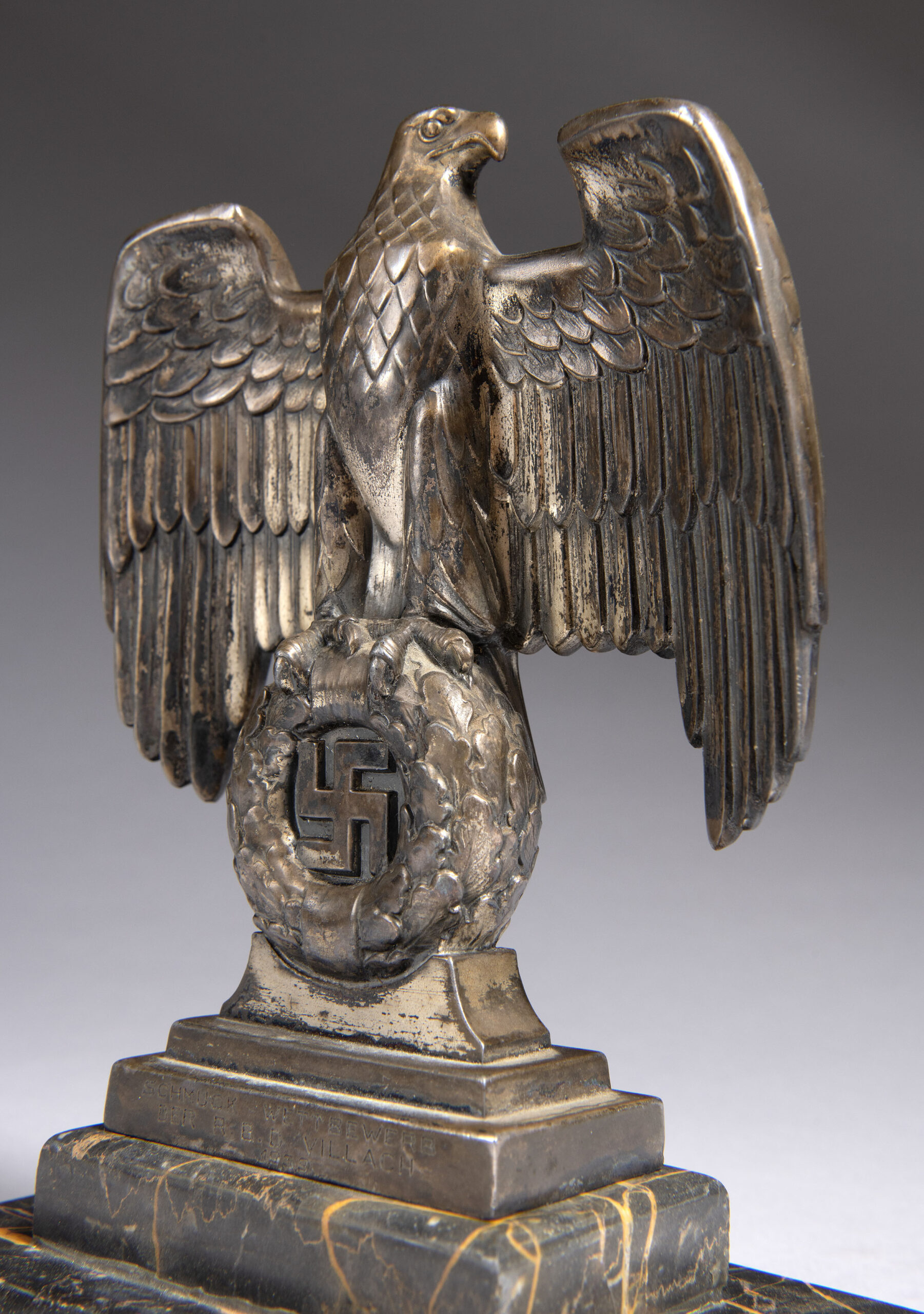Nuremberg Desk Eagle
Eagle dated 1939 modeled after the massive 6-meter tall iron eagles positioned on each side of the main podium (Ehrentribüne) at the Party Rally Grounds in Nuremberg. Designed by the preeminent sculptor Dr. Kurt Schmid-Ehmen who is considered to have conceived the official Reichsadler for the Third Reich. This example is a Parteiadler rather than a Reichsadler, differentiated by its head facing right. Engraved at base with the text “SCHMUCK-WETTWEWERB, DER R.B.D. VILLACH, 1939”.
The history of the Reichsadler (Imperial Eagle) dates back to the Roman era, and was used by the Holy Roman Empire (HRE) – a feudal German polity – as its heraldic motif derived from the Roman eagle and continued to be used by successive German states. Lasting from the 10th to the 19th century and stretching from the Meuse to Vistula, the HRE is considered the feudal predecessor to the modern German state. This perennial continuity in German statehood was often alluded to by the Nazis, with the HRE being referred to as the “First Reich” in Nazi nomenclature, preceding the Imperial “Second Reich” and Hitler’s Third Reich.
This fabled medieval empire was romanticized as part of the national myth espoused by the Nazis of an idealized, pre-enlightenment Germany. Naturally, much inspiration was taken from its feudal concepts such as its Imperial Eagle motif, adapted to fit the needs and workings of the new reich. The calls for a Tausendjähriges Reich (Thousand-year Reich) sought for the Third Reich to emulate its millennia-spanning predecessor.
Free shipping on orders over $50!
- Satisfaction Guaranteed
- No Hassle Refunds
- Secure Payments
Eagle dated 1939 modeled after the massive 6-meter tall iron eagles positioned on each side of the main podium (Ehrentribüne) at the Party Rally Grounds in Nuremberg. Designed by the preeminent sculptor Dr. Kurt Schmid-Ehmen who is considered to have conceived the official Reichsadler for the Third Reich. This example is a Parteiadler rather than a Reichsadler, differentiated by its head facing right. Engraved at base with the text “SCHMUCK-WETTWEWERB, DER R.B.D. VILLACH, 1939”.
The history of the Reichsadler (Imperial Eagle) dates back to the Roman era, and was used by the Holy Roman Empire (HRE) – a feudal German polity – as its heraldic motif derived from the Roman eagle and continued to be used by successive German states. Lasting from the 10th to the 19th century and stretching from the Meuse to Vistula, the HRE is considered the feudal predecessor to the modern German state. This perennial continuity in German statehood was often alluded to by the Nazis, with the HRE being referred to as the “First Reich” in Nazi nomenclature, preceding the Imperial “Second Reich” and Hitler’s Third Reich.
This fabled medieval empire was romanticized as part of the national myth espoused by the Nazis of an idealized, pre-enlightenment Germany. Naturally, much inspiration was taken from its feudal concepts such as its Imperial Eagle motif, adapted to fit the needs and workings of the new reich. The calls for a Tausendjähriges Reich (Thousand-year Reich) sought for the Third Reich to emulate its millennia-spanning predecessor.









